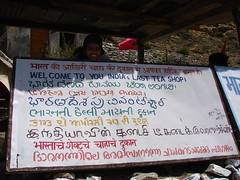What would you do if you had only an evening in Guwahati? Spend those precious hours at the expanse of the calm and unhurried Brahamputra. That’s what we did.
We were at the fag end of our 21-day sojourn through the north eastern states. We were in Guwahati for just a night before catching our flight back home.
From the hotel we hailed a rickshaw and said “Ghat”. Looking at us and seeing that we were not locals he raised his eyebrow and said “Suruj “. Yes, we wanted to see the famed sunset on the Brahmaputra River.

‘There’s a sunrise and a sunset every single day, and they’re absolutely free. Don’t miss so many of them.’
– Jo Walton.
We were dropped at the Fancy Bazaar Ghat. A few boats were anchored to the shore, swaying to the lullabies of the waves. A few others, probably the last ones of the day, were trying desperately to get back to the shore. It was only 4.30 pm, but the sun was already down to its brightest red.
The river completely mesmerized us. Not only with its beauty, but also with its sheer size and huge expanse. How can you call something so vast like Brahmaputra, a river?
Brahmaputra looked more like an ocean – a moving one. It’s so different to sit by a river, who is addressed in the masculine gender. Brahmaputra, Son of Brahma, the only ‘Nad’ (नद) in India. You get a different kind of vibe from ‘him’; you can feel the strength and energy, the hidden danger lurking inside the depths, often expressed when he comes to full strength, during monsoons.

‘From within or from behind, a light shines through us upon things, and makes us aware that we are nothing, but the light is all.’
– Ralph Waldo Emerson
Brahmaputra is the life line of Assam. More than the religious importance, this river evokes a sense of pride in the people. At the same time people have suffered when the river has come full throttle.
“Luitor Bolia baan, toloi koloi nu dhapoli meliso, hir hir sowode kal roop dhori loi kaak nu bare bare khediso.” [Jayanta Hazarika]
“Oh the maddening floods of Luit, where are you heading this time. Whom are you chasing again with the frightening sound of your waves.”
We walked along the banks to get a better view of the sun. The banks were not without the usual share of the city’s grime. Did we hear a silent scream? “Clean me and preserve me for posterity”. Did we miss his pain in our relentless effort to capture one of his golden moments in our cameras.
Was he calling to us silently, welcoming us to explore the deep waters. The smallest river island – Umananda Island – in his midst beckoning us to the shores. We didn’t venture in.

‘It was good to be a little island. A part of the world, a world of its own. All surrounded by the bright blue sea.’
– Margaret Wise Brown
Why does this river take many a name in its course, even if the water that flows through the river beds is the same. Originating as Yarlung Tsangpo from Kailash Manasarovar in Tibet, in Arunachal Pradesh, Brahmaputra is known as the Siang River. In Assam, Brahmaputra River is also known as ‘Luit’ or the red one.
But what’s in a name, right? I could be anyone you would want me to be.
It was finally time for our journey back to reality. The magic of Brahmaputra was coming with us. Just like the music of Bhupen Hazarika, known as the bard of Brahmaputra, whose soulful renditions traveled thousands of miles beyond these shores.
And as we flicked the sand off our clothes and made our way to a waiting rickshaw, we turned back for one more time to look at him. He didn’t let us down. Brahmaputra still glistened like gold in the setting sun.
Photo credits: Rajesh


































